LE MANS CLASSIC 2025
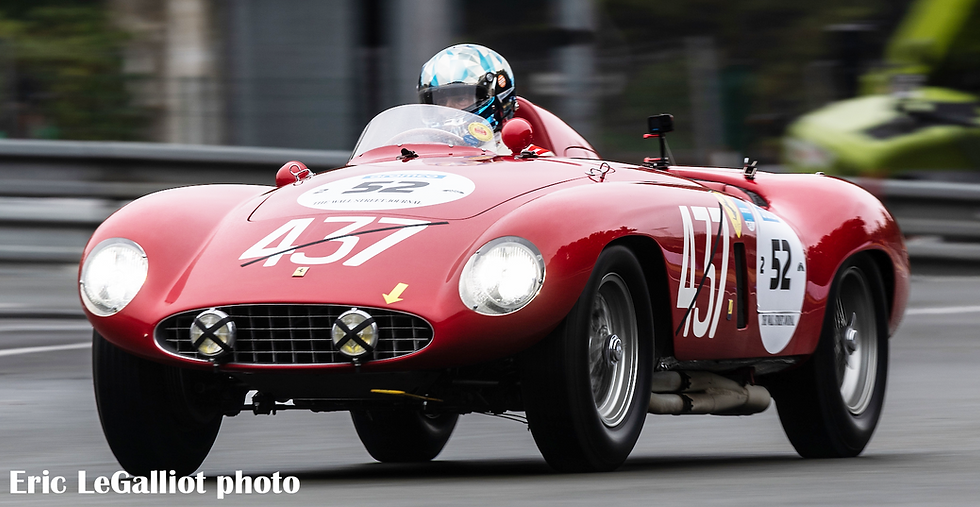
Marc Sonnery
Volume 50 Issue 14
Jul 26, 2025
The Le Mans Classic is becoming THE place to be each year. Various classes of historic Ferraris and others race around the clock recreating the feel of the original 24-hour race.
Le Mans Classic, started in 2002, has been the largest classic racing event in Europe and the world for several years now; it is truly established as an institution just like the 24 Hours which celebrated its centenary two years ago. The twelfth edition of LMC took place July 3rd to 6th.
More than 238,000 people attended from all over Europe and beyond, 3,000 more than the previous 2023 edition. In the huge press room, a nice place to rest above the pits with A/C and lots of screens, were media from all over Europe, the US, and Japan. The airport next door was crammed with jets and helicopters.
Founder Patrick Peter of Peter Auto, the creator of this marvelous event along with the Tour Auto and Chantilly concours among others, has sold the company to Marc Ouayoun, a former Audi France CEO.
A major announcement regarding the future of Le Mans Classic was made three weeks earlier during the 24 Hours of Le Mans weekend.
LMC, which has been every two years since its inception, will now become an annual event. There will however be two versions of it, which will alternate.
One will be the Le Mans Classic Legends for cars made between 1976 to 2015, the first edition of which will take place July 2-5, 2026, while the LMC Heritage for cars from 1923 to 1975 will debut in 2027.
This new configuration addresses the passing of time. The increased number of racing cars from the late 20th century and up to 2015, drivers who want to race them and the slowly diminishing number of drivers racing the earliest pre-war cars. It allows more people and cars to participate every two years as the number of applications always significantly exceeds the possible entries.
Ouayoun explained that he could not, for example, accept every Porsche as the number of “Stuttgart Piggies” (my saying not his) having taken part in the Sarthe round the clock race over the past decades is overwhelming. It is critical to ensure that the field has variety. To avoid that imbalance a Porsche Classic race is part of the program now with yet another large grid.
The phenomenon of owners racing tool room replicas, built to exacting specifications, of the important Ferraris they own is now well established. Don’t blame them, blame the rising value of these cars. What would you do? Think about it. Protecting the real one by racing a perfectly made copy with no risk of metal fatigue or other age-related failures makes sense.
Those who complain about not wanting to watch replicas race are disingenuous; they have no idea of costs, and the fact is that the visual, aural experience of watching, hearing an alloy-bodied Ferrari V12 with correct shape and engine spec is no different from the real one. You can still see the real ones at concours or museums...if inert cars are your thing.
Among these we had the 312 P, S/N 0872 R of Swiss Arnold Meier, owner of the real 0872, which was raced for years by David Franklin who has now retired, so in his stead we had Swiss Remo Lips, already seen in that car at LMC before, and German Frank Stippler, both quick pedalers.
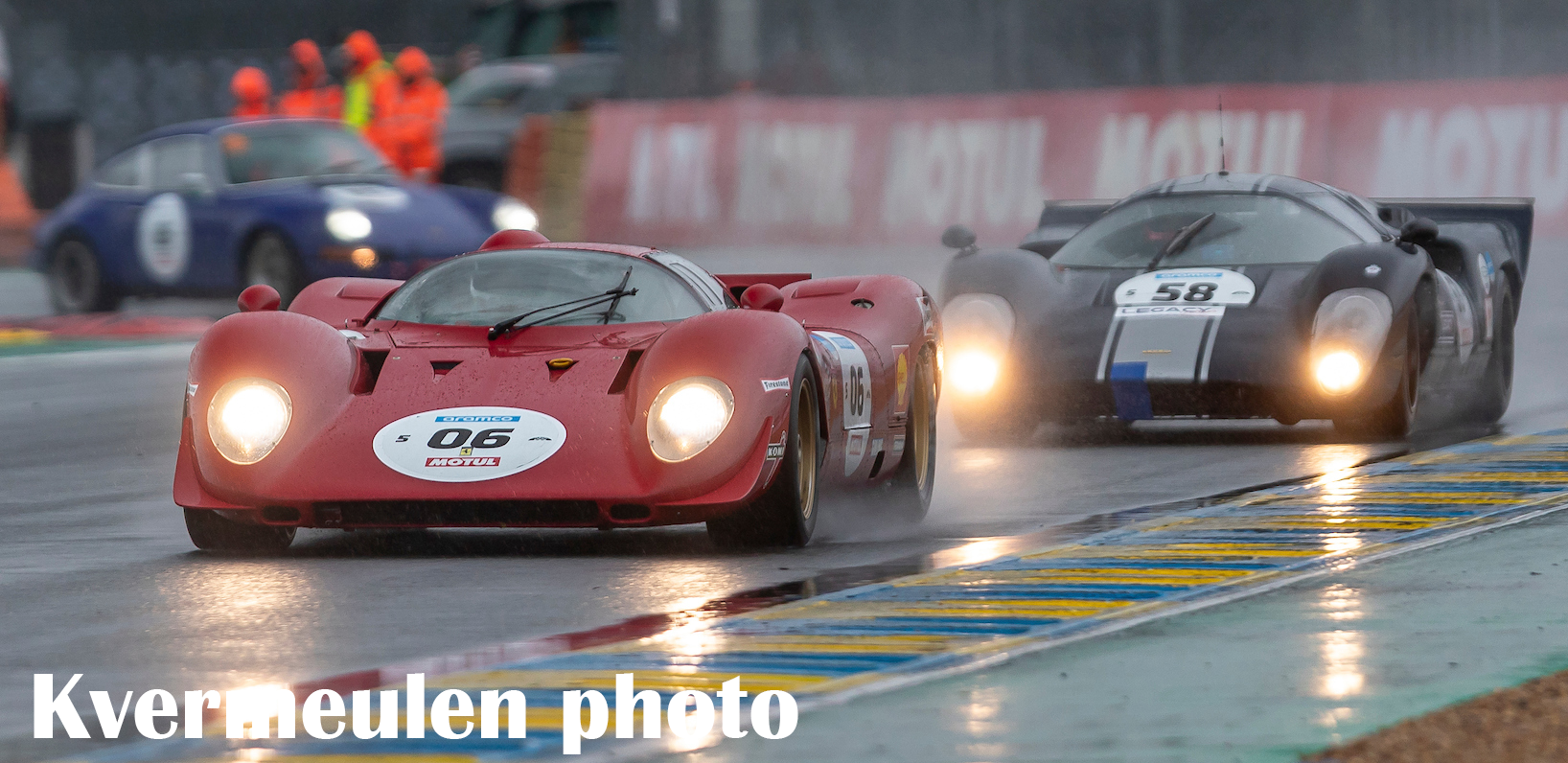
The 512 M S/N 1002 R of Martin Halusa was bought in recent years along with the real 1002 from Brazilian Carlos Monteverde who had crashed the replica at Brands Hatch with slight injury a couple of years ago. It was driven by Halusa’s son, Lukas.
Likewise, the 250 GT Breadvan tool room copy was entered by the same Martin Halusa who owns the real one. It was driven by both his sons, Niklas joining Lukas.
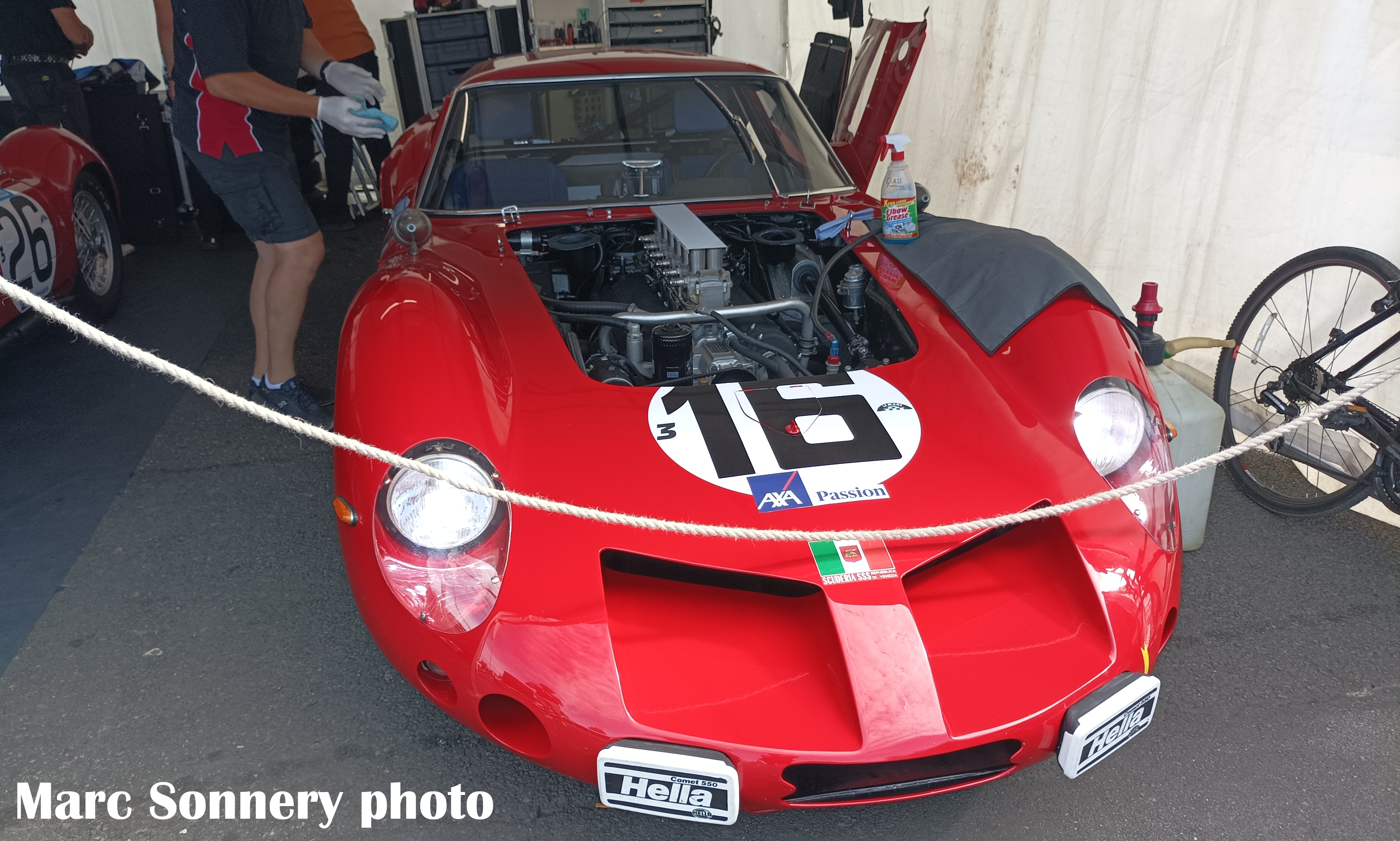
This replica trend is not exclusive to Maranello; one Le Mans icon was back, also in the form of a tool room copy, the one-off 1964-65 Maserati Tipo 151/4 with its ominous shape, call it Maserati’s answer to the Breadvan.
The real one was destroyed in Lloyd “Lucky” Casner’s fatal 1965 April test day, so this one was made from scratch with a correct engine. Alas it had a small fire on its very first practice lap and was not seen again replicating...its period curse.
A new entry was the 1954 121 LM Scaglietti Spider S/N 0484 LM of Elad Shraga and Guy Emodi from Israel. It started life as a factory experimental car with a 3-litre engine in three races in Argentine with little success. Back in Maranello the wheelbase was extended by 14 centimeters to 240 cm. This made a big difference as Piero Taruffi then won the Giro di Sicilia in it on April 3rd, 1955.
It came in fifth at the Nürburgring Eiffel races with Giuseppe Farina, after which it was modified once again in the spring of 1955 at the factory to 121 LM spec and given its distinctive body by Scaglietti.
In the summer it was acquired by Tony Parravano, an Italian immigrant who became a major California construction magnate and had close ties with Enzo Ferrari as he helped those workers who wanted to emigrate.
Parravano’s passage in the racing scene was like a comet, brief, less than a decade long, but very influential as he owned and entered a lot of racing Ferraris and Maserati with major drivers like Shelby, Hill, Gregory....but like a comet he disappeared into Mexico in 1960 when the IRS came after him for tax evasion.
The 121 LM was first raced for him at Oulton Park, UK, by Carroll Shelby, in Caracas by Maglioli and then in the US at Torrey Pines, retiring each time. It did win with Phil Hill at Palm Springs on April 7, 1957, after which the car was seized with several others and sold in 1958 by the IRS.
A former Parravano mechanic later acquired it, but Rodger Ward crashed it at Riverside and the dismantled car sat over 25 years until it and other cars were bought as a lot by UK restorer David Cottingham in 1985. In recent years it was acquired by Leslie Wexner until Shraga bought it last year.
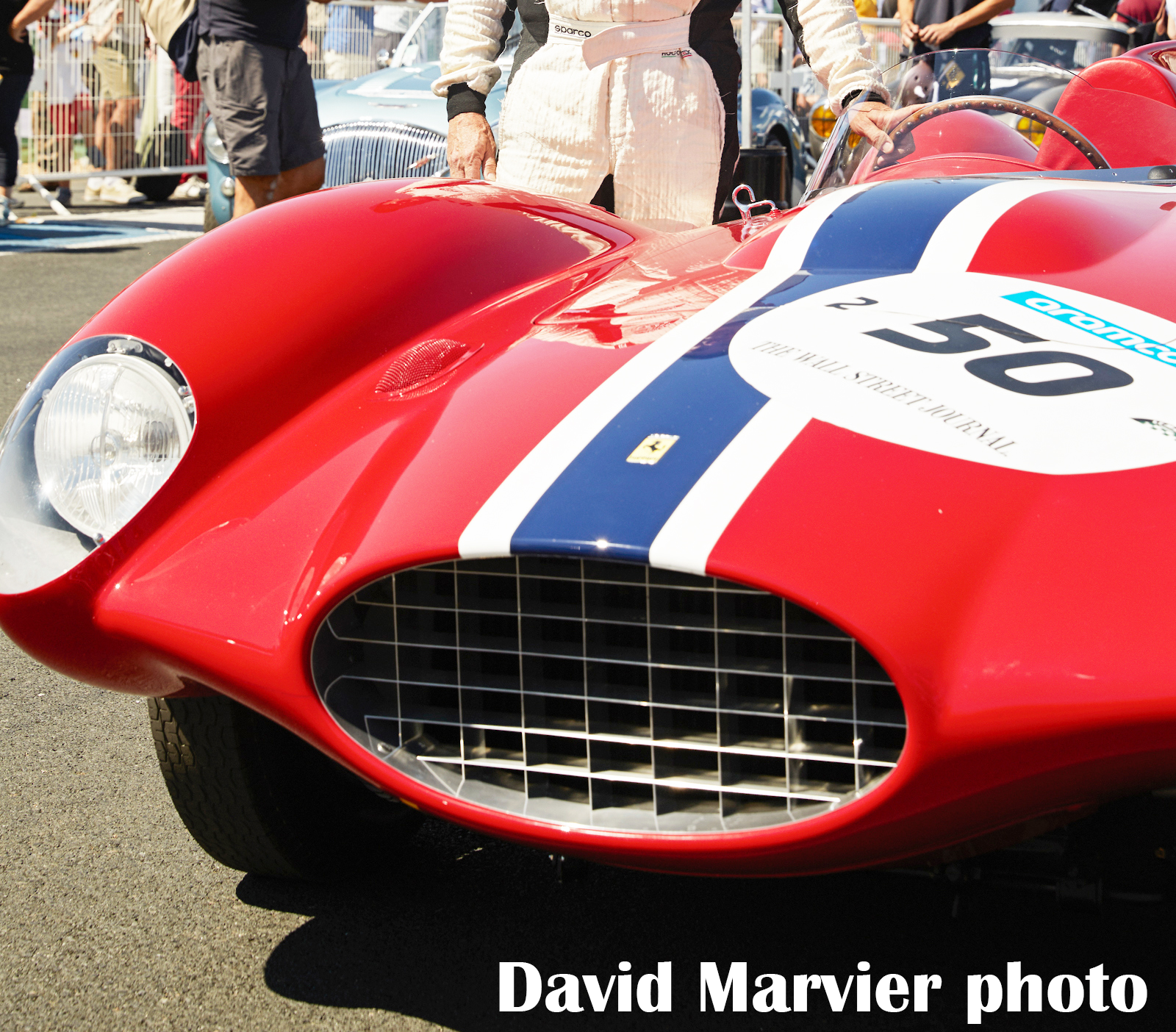
Another welcome new addition to the field this year was the 1955, 735 LM, S/N 0546 LM, of New Orleans’ John Houghtaling, co-driving with Franco Valobra and Jerome Bocuse.
S/N 0546 LM began its life as a 118 LM entered as a factory car in the Mille Miglia with Piero Taruffi who did not finish due to engine failure. After being modified to 121 LM specs the car took part in Le Mans with Harry Schell and Maurice Trintignant, this time the clutch caused retirement.
It was then sold to oil baron William Doheny in Beverly Hills, with Ernie McAfee driving for him. In January 1956 he was again second in Torrey Pines before winning the preliminary and main in Santa Barbara in March.
Then tragedy struck on April 22, 1956. During the Del Monte trophy at Pebble Beach, he veered off course, hit a tree and perished. Another driver was badly injured that weekend. All this was to have a momentous effect on the Monterey peninsula. As a consequence, the Laguna Seca circuit was built 20 minutes inland and inaugurated two years later.
After that sad day the car stayed in the family and was slowly restored over two years. Famous racer Chris Cord, a relative of Doheny, raced it once, at the very first Monterey Historics, as a farewell for the family, before it was sold to Bill Ziering of Los Angeles.
He became a stalwart of the same event until 1995. Two years later it was acquired by Todd Morici who raced it at Lime Rock in the historic challenge in 1999.
John Houghtaling then acquired it at RM Sotheby’s Monterey auction in 2017, competing in the Mille Miglia last year with his wife Yulia, a former pop singer who can make the car dance like a concert audience.
This year has been very active for John and Franco Valobra with the Giro di Sicilia and the Mille Miglia.
John shared what it like discovering the legendary French course: “Speeding down the Mulsanne Straight at night at Le Mans in these two prototypes is every bit as exhilarating and scary as I dreamed. Going to try to sleep 1.5 hr. Hard to do [with the adrenaline]. Next stint at 3:30 AM, LM brakes need sorting, as does the steering and balance on the Monza.”
Yes, as if one car was not enough he also ran a 1955 750 Monza; S/N 0530 M in the same grid the same “plateau” #2 so the three drivers were certainly busy.
S/N 0530 M was sold new to Count Luigi Bordonaro di Chiaramonte in Palermo, Sicily. He raced it numerous times on the island, winning three hillclimbs in it, at Messina and twice at Monte Pellegrino.
Fellow aristocrat and Palermo neighbor Baron Bernardo Cammarota acquired it in the late 1950s. He raced it once in the 1960 Targa Florio but retired. He sold it and from 1962 to 1973 it was displayed in the Monza Autodrome Museum. It then went through the hands of numerous owners, in recent years by Houghtaling. His wife Yulia just drove it in the Mille Miglia this year.
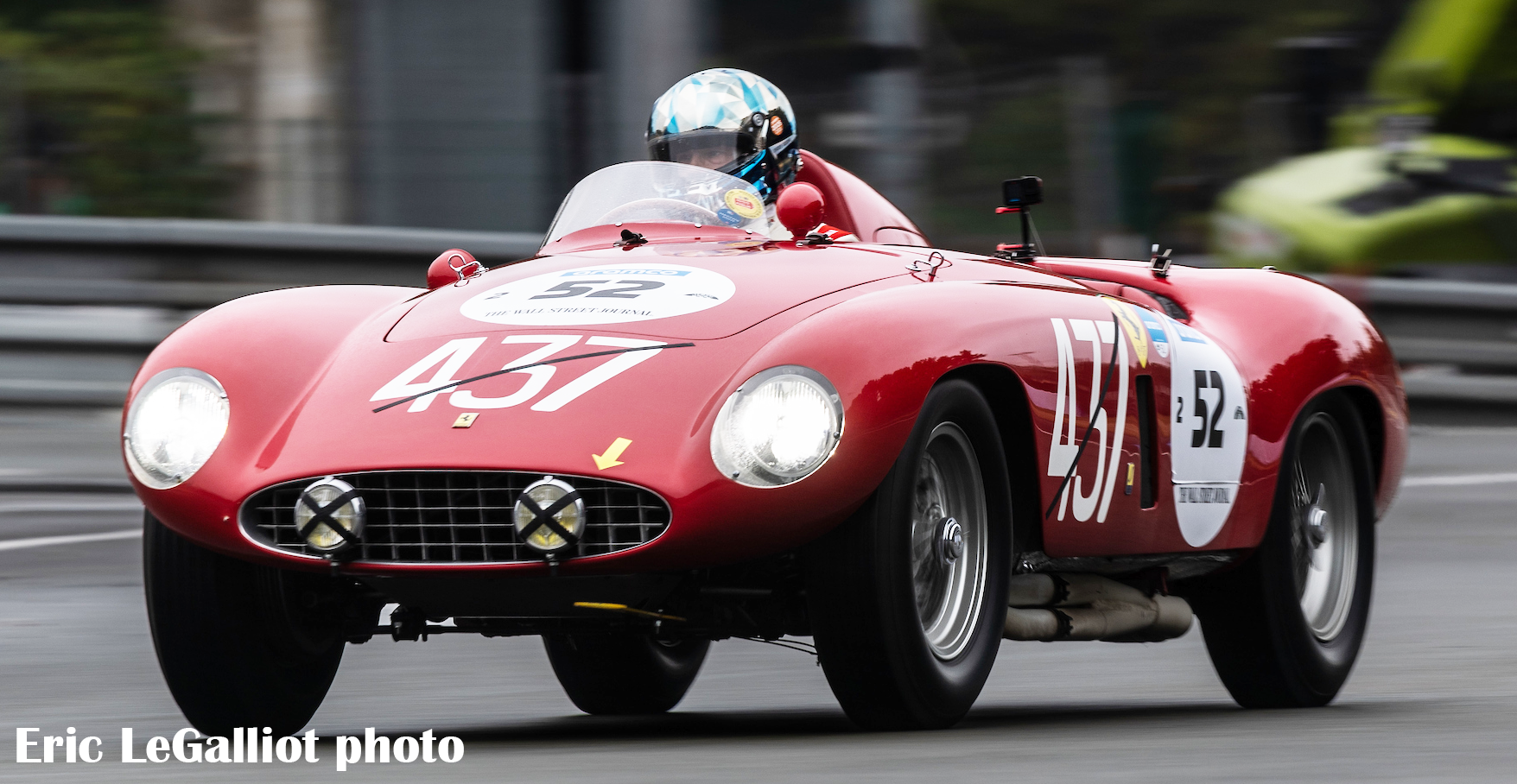
Grid 3 included no less than five 250 GT SWBs, a grid that would see the overall victory of the SWB S/N 2245 GT raced by Diego Meier and Remo Lips.
Grid 4 included two 250 LM tool room copies, that of Dutchman Van der Lof and Brit Clive Joy, the 275 GTB/4 S/N 09247 of Dutchman Jan Gijzen, a 275 GTB built by Motorima in Sweden owned by Danish driver Jakob Viggo Holstein who was joined by former F1 driver Jan Magnussen discovering Le Mans Classic aboard several cars.

In grid 5 apart from the 512 M and 312 P there was South Africa’s Paolo Cavallieri who was back with his Daytona S/N 14297, co-driven by Maurizio Bianco.
German Jörg Bratke von Bergen and Olivier Louisoder shared the wheel of another converted 365 GTB/4 Competizione.
Grid 6 included three Ferraris, the 512 BB/LM S/N 44023, a car never raced in period, of Olivier Breittmayer.
The BB/LM S/N 34445 of Alexander Rittweger, sold new to Ron Spangler, retired three times at Daytona and once at Sebring, later raced extensively by John Goodman of Seattle in the historic challenge.

A 308 GT4 replicating the NART entry that was withdrawn in period by Luigi Chinetti was entered by Frenchmen Eliano Celli and Mickael Marie.
Time for the races.
The honorary starter waving the flag was none other than former Ferrari F1 driver and 2008 World championship runner up Felipe Massa. He first gave the start at 13:20 for the Little Big Mans, the kid’s race in motorized model cars. These are very impressive and among numerous scaled-down Ferraris my favorite was the Daytona Spyder enjoyed by a lucky young girl.
This is not only a popular event as the kids race for a few hundred yards on the main straight in front of packed, cheering grandstands and very nervous, doting, fretting parents, but cleverly ensures the passion is transmitted to the next generation, call it motorsport incubation!
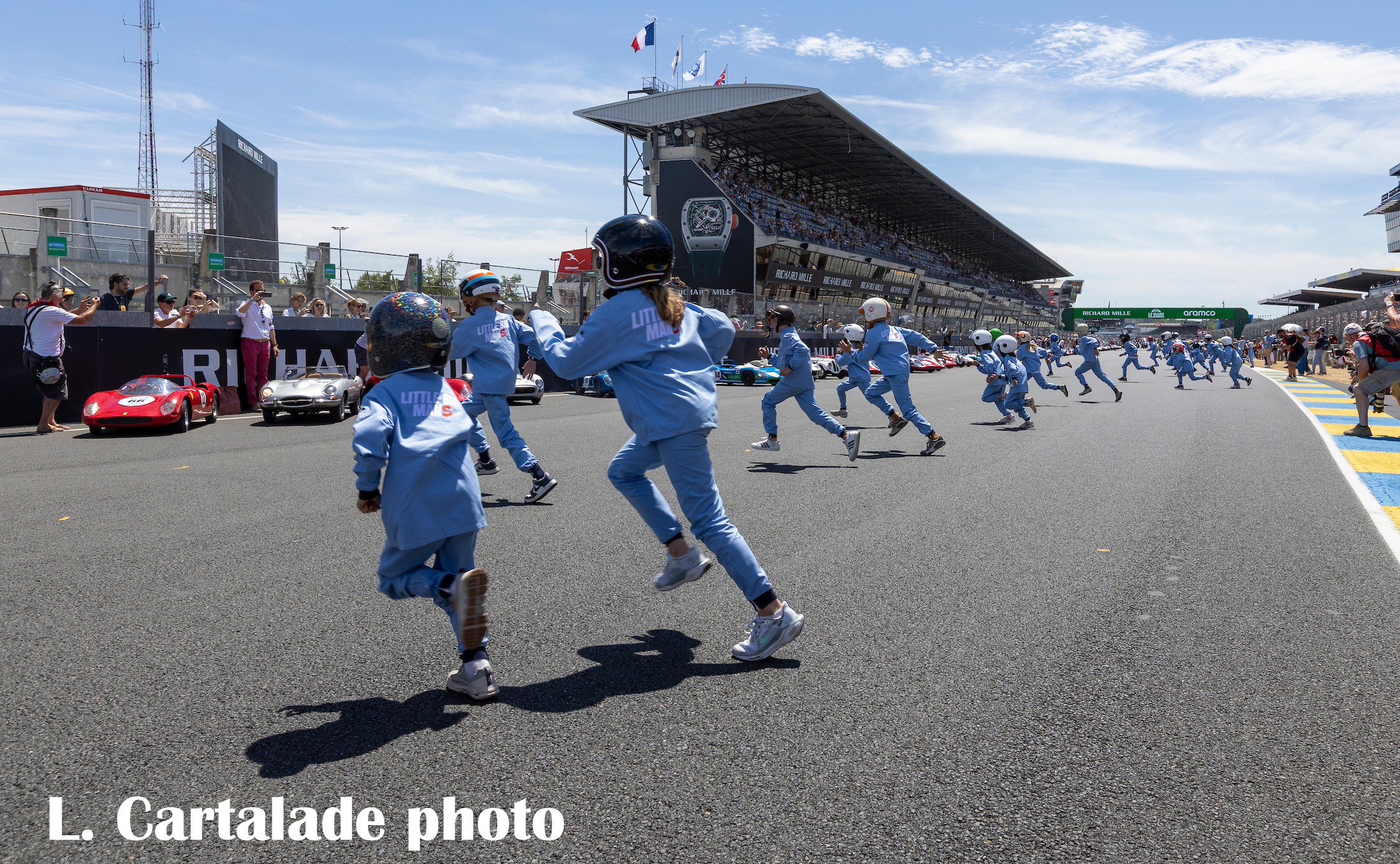
At 4 PM on Saturday, traditional race start time for the actual 24 Hours, Massa waved the French flag, and the event roared into action with the first rave of grid 4.
There was unexpected comic relief as a driver seemed confused about which car he was supposed to run to as he had stopped and waited across from the wrong red Alfa, so he suddenly ran sideways to his own car!
Such clown shows did happen occasionally in period. It was Jacky Ickx in 1969 who gave the running start its coup de grâce by walking across the track in protest to what he considered a dangerous custom. After that from 1970 onwards, drivers waited in their cars, properly strapped in and the rolling start was soon adopted.
The Circuit de la Sarthe is of course eight miles long, 13.6 kms; four times as long as Laguna Seca and twice as long as Elkhart Lake.
You can’t watch from the side of the whole course, but most do from the Porsche curves, past the pits, the Dunlop Chicane and famous bridge onto the beginning of the Mulsanne Straight.
Watching the racing in the forest at the Indianapolis-Arnage section is a treat as the circuit is unchanged in that section, apart from the guardrails, fences and gravel traps, so contrary to the pit area with its huge modern building you get that time machine feeling especially at night with the glowing disc brakes and turbo cars shooting flames upon deceleration.
Cars approach at top speed the fast slightly banked third gear corner of Indianapolis before reaccelerating for a short straight to the slowest one on the course, Arnage, second gear, about 80 kph, and accelerating to full speed yet again towards the distant Porsche curves.
Then around midnight, after three sunny days, the rains came. Consistent. All day Sunday.
During the night rain there was a multiple car crash, a five-car pileup, with thankfully no injuries, which caused a red flag and necessitated barrier repair. This resulted in a lengthy delay and race cancellation for a couple of plateaus, but each grid still had their third race on Sunday.
In Grid 5 the 512 M of the Halusas and its caretaker Alex Ames won the first race; the second one, aborted after that crash, was won by a thin margin by the spectacular and fan favorite 312 P while the third was won by a Porsche 908. The 512 M was aggregate winner though.

A final grid was the one called Endurance Racing Legends for Le Mans sports prototypes and GT cars built between 1990 to 2010.
This field included a yellow 333 SP, chassis 034, of Raymond Narac with co-driver Michel Lecourt, that high-pitched howl beloved by many. A 360 Modena N-GT, a 430 GTC EVO entered by Floridian Charles Scardina and two Maserati MC12 GT1s.
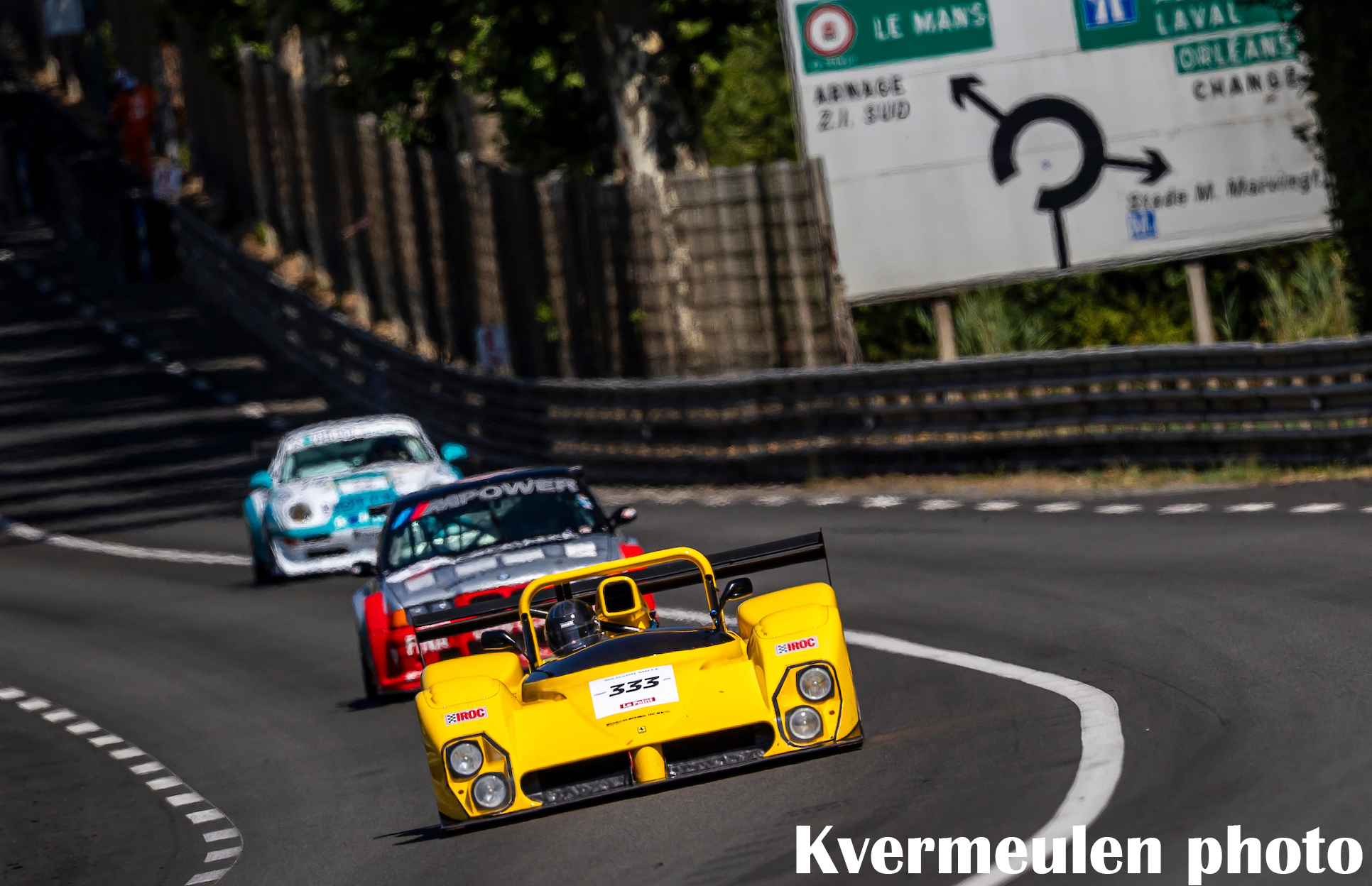
There were some notable drivers, both pros such as five-time Le Mans winner Emanuele Pirro and lady racer Claudia Hürtgen. In Group C cars you could find former Lotus F1 team owner Gerard Lopez in a Porsche 962 C.
As mentioned earlier Denmark’s Jan Magnussen, former F1 driver, (like his son Kevin) was not only sharing the wheel of a 275 GTB but also a 1986 Tiga.
Another former F1 driver, Jan Lammers (in something very different to what he is used to - a 1929 Bentley!).
Andy Wallace, 1988 Le Mans winner with Jaguar, Brian Redman, 88 years young, racing a Porsche 917 with Philippe Siffert son of the late Jo, Belgian Eric van de Poele, former 333 SP racer and Sebring 12-Hour winner in 1995 and 1996, and personalities such as Jim Farley the CEO of Ford in a Lola T298 in Grid 6.
Watch tycoon and major sponsor benefactor Richard Mille was co-driving a 1976 TOJ SC304 which was among the quickest cars in Plateau 6. Mille is having a new museum built at the circuit which will house not only the current museum’s cars, in a much better, larger facility, but also most of his vast collection. He is really proving to be a wonderful patron of motor sports and classic car events.
As usual there were about 8,000+ classic cars in the club enclosures located on the small permanent Bugatti circuit behind the huge paddocks; cars coming from all over Europe. I did not have time to hunt for Maranello road cars there this year.
The village of temporary shops was enormous with countless merchants offering scale models, racing art, clothes, and accessories. There were stages with bands and dancing to 1960s hits, period hair salons and countless eateries from hot dog sellers to Champagne bars.
Small road trains and vintage buses ferry spectators, bands riding around playing in 1960s tail-finned Cadillac convertibles, oh and there were concerts as well with moderately famous singers, all of which created a joyous atmosphere for the Pan-European spectators.
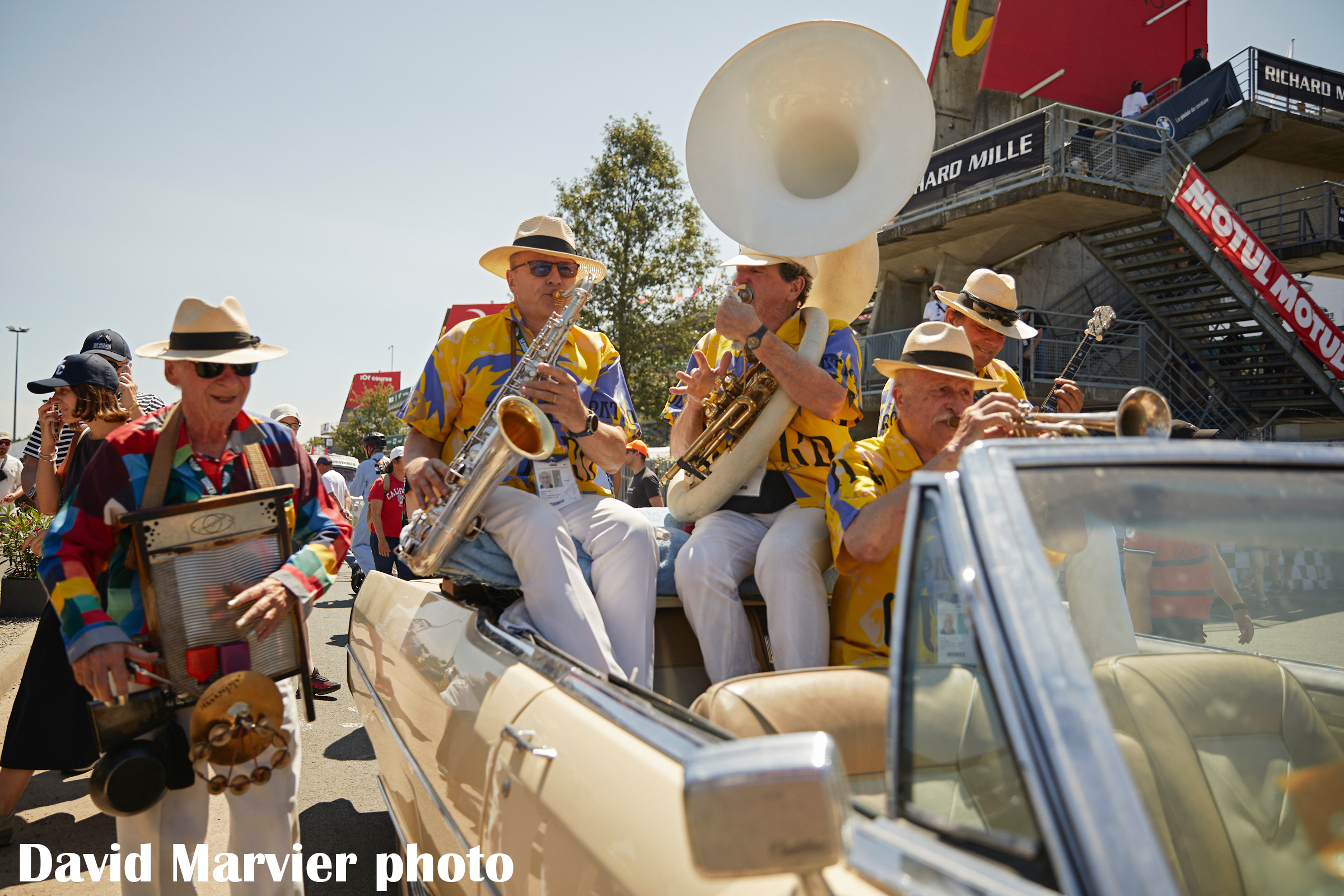
There was no auction at all this year. You could therefore say Le Mans Classic is the polar opposite of Monterey week: pure passion, 100% historic racing with no speculation perverting it. Now you know why this pen pusher and so many others never miss the Sarthe event.
The great news is we don’t have to wait two years anymore: here’s to LMC 2026; the inaugural Le Mans Classic Legends for cars made between 1976 to 2015 will take place July 2-5, 2026.
If you want to attend a historic race meeting in the old world this, either version, is the one. For more information see https://www.lemansclassic.com/en/
